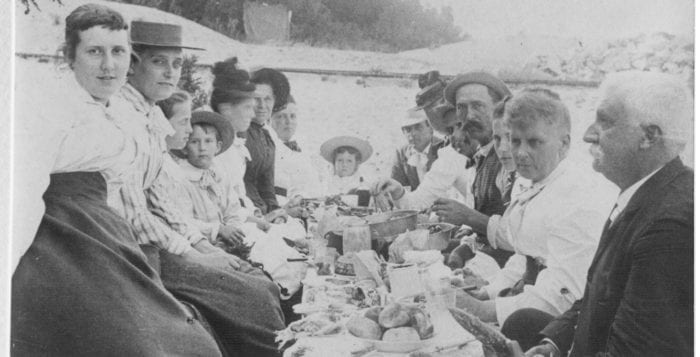New book puts the spotlight on Kings Park’s history

By Jill Webb
Before it was Kings Park, the suburban hamlet in Smithtown was known as St. Johnland, a utopian Christian community founded as a haven for poor members of the Protestant working class and orphaned children.
In the newest installment of the Images of America series, you can learn all about the history of Kings Park — which just celebrated its 250th anniversary in 2016.
The co-authors of “Kings Park,” Smithtown historian Bradley Harris, the Director of Collections and Interpretations at the Long Island Museum Joshua Ruff and the Executive Director of the Smithtown Historical Society Marianne Howard came together and selected more than 180 vintage photographs to be featured in the book, along with captions detailing the images relevance within the history of Kings Park.
Howard set aside time from supervising the day-to-day activities at the Smithtown Historical Society to contribute to the book and said it took two years to compile images.
She noticed in her research that most small, American towns all underwent the same transformations from colonization to industrialization. The unique aspect to every small town is the people and resources they contribute which Howard said is what is highlighted in the book.
“I hope that the people from Kings Park see people and places that they know in the book,” Howard said in a phone interview. “That’s what they should be excited about — seeing how their own community transformed the history here in this part of Long Island.”
The book’s chapters are titled St. Johnland, The Kings Park Psychiatric Center, Early Kings Park, Churches and Schools, and Building Modern Kings Park. The book’s authors divided the chapters based on personal interest and selected the photos collaboratively.
Ruff, who has been a consulting curator for the Smithtown Historical Society for over 10 years, said the image-centric format is an “immediately accessible and terrific way of connecting” with the community of Kings Park and those who are interested in its history.
But Howard, Ruff and Harris were not the only ones putting in the research — the community was also able to participate. The authors said they were grateful to receive private collections of photographs from residents that are featured in the book.
“When we thought that we were finished with what we had, other people were coming forth with their photographs that had something a little bit different that we wanted to share with everybody else,” Howard said. “What’s great about Smithtown is that many people have a strong connection to the town and have lived here for either their whole lives or are third or fourth or fifth generation Smithtown residents.”
In completion, the authors “really felt like it was a good balance of architectural and social history,” Ruff said.
One section Howard finds particularly interesting displays how the wave of immigration brought on by the Kings Park Psychiatric Center shaped the town, along with how the town dealt with — and is still dealing with — the after-effects of its closure in 1996.
The caption a photo of the hospital’s Building 93 describes it as “now obsolete, unsafe and a magnet for vandals.” It goes on to describe the building as a “decaying symbol of a past age,” which makes residents wonder when the buildings on the grounds will finally be demolished.
Howard noted Kings Park has received funding for downtown revitalization. The proposed plan hopes to reshape Main Street by initiating “the economic strength of the community and provide a center of activity for residents to enjoy,” according to the action report prepared by Vision Long Island, Inc., the group hired to create the revitalization plan. The action report said the fate of the psychiatric grounds has yet to be determined.
“I think the community has grown enormously over the last 100 plus years and the book really shows how it’s evolved,” Ruff said. “The community has grown into this large multi ethnic suburban community that now has plans in place for major downtown changes in the next couple of years that will help to continue the changing evolution of the place.”






